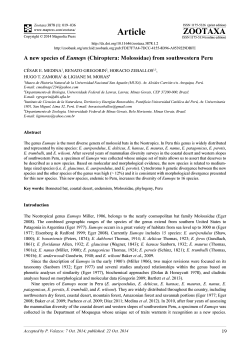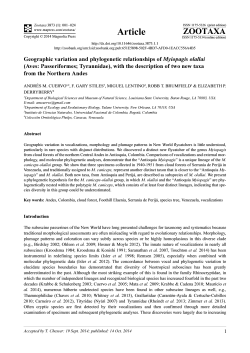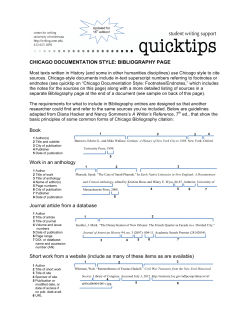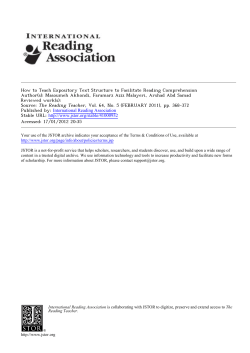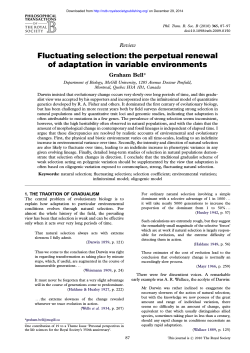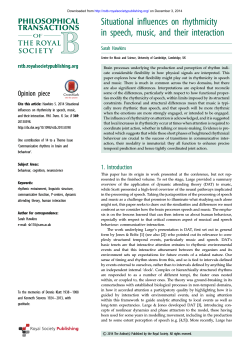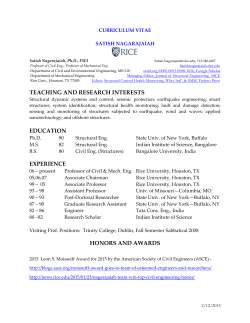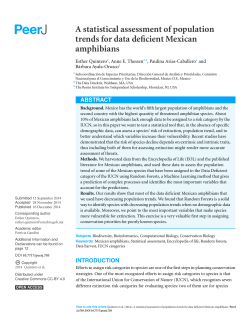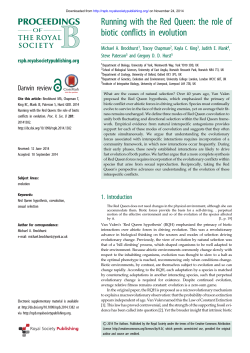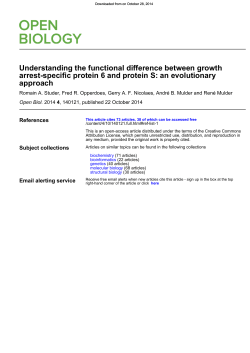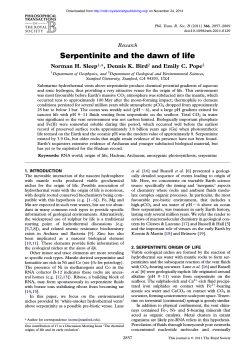
Document 338995
© June - July 2014 they didn’t know what was keeping me alive then Reducing polypharmacy t tw sm A logical approach olypharmacy is the use of multiple medications by a patient. It is rapidly increasing in affluent populaP tions worldwide, posing an increasing challenge for patients, their families and care providers.1,2 From 1998-2008, Canadian seniors taking more than 5 prescription drugs doubled from 13% to 27-30%.3-5 A patient taking more than 10 drugs was once an anomaly. Now this applies to 4% of British Columbians age 85 or older and 31% take at least 5 drugs. Percentages are much higher in long term care. See graphs at our website. British Columbia has the lowest per capita drug costs in Canada, 27% below the national average, due in part to lower polypharmacy.6 The difference was estimated to be about $341 million/year in 2013. However, current data suggest that there is ample room to improve.7,8 Exuberant prescribing is driven partly by population aging, but also by agressive marketing and application of chronic disease management guidelines that do not account for the complexities of multi-morbidity.9 This affects costs, can worsen health status and often is not genuinely evidence-based.10-14 Randomized controlled trials (RCT) mostly study idealized populations and can not reliably detect less common or long term harms, thus underestimating adverse effects of drugs.15 Potential serious or even life-threatening adverse drug reactions (ADR) are not always considered in routine prescribing. ADR increase with age and the number of prescribed drugs. Even in the Emergency Department, many are not identified 16,17 and feedback to the prescriber(s) may be ineffectual. Complex medication regimes make it more difficult to prevent acute ADR, assess potential drug interactions, and to recognize chronic but subtle drug toxicity even during professional encounters, let alone for the patient at home. Some advocate multidisciplinary team approaches or even hospitalization to address this challenge.18,19 A Cochrane review of formal interventions in care homes did not find evidence for real world benefit 20, whereas another in people > 65 concluded that at least “inappropriate prescribing” and ADR can be reduced. 21 Using a simple approach based on a formal algorithm, an experienced Israeli geriatrician achieved a 58% reduction in polypharmacy in very elderly people, a mean reduction of 4.4 drugs per patient.22 A similar approach has also been advocated in Australia.23 1 2 f s but I feel much more alive now 3 Rational prescribing requires restraint and wisdom in initiating chronic drug therapy, but also fundamental change in our philosophy of medicinal care. Complex medication regimes should be challenged routinely, and simplification welcomed when it can improve health. This Letter describes 7 steps that doctors, pharmacists, nurses, patients and their families can employ to become adept at “deprescribing”. 1. Re-evaluate the goals of therapy “Guideline-based medicine” drives much modern prescribing, but is often based on surrogate outcomes (e.g. A1C, bone density, blood pressure).24 This may relate poorly or not at all to patient values and aspirations. For example, when quality of life clearly trumps longevity, using drugs intended to prevent death can be irrational. Conversely, when survival is paramount, drugs that increase mortality are inappropriate (e.g. antipsychotics in elderly people with dementia). A good starting point is to re-evaluate the goals of therapy. Symptomatic treatments should meet a test of common sense: do this medicine’s benefits meaningfully outweigh its harms? Drugs which slightly reduce symptom scores in a population are only worthwhile to the individual if their effect improves the quality of that person’s life. If this cannot be demonstrated by a short therapeutic trial, there is no point in persisting.25-27 Since all drugs cause significant problems for some people, especially frail elders, symptomatic benefits should clearly outweigh the associated harms. Preventive treatments also warrant reappraisal. In the face of multiple or serious degenerative conditions expected to reduce longevity, are long term preventive strategies still relevant?28 Mailing Address: Therapeutics Initiative The University of British Columbia Department of Anesthesiology, Pharmacology & Therapeutics 2176 Health Sciences Mall Vancouver, BC Canada V6T 1Z3 Tel.: 604 822•0700 Fax: 604 822•0701 E-mail: info@ti.ubc.ca www.ti.ubc.ca 90 June - July 2014 Diminished quality of life, serious adverse effects, or higher costs may outweigh the low probability of benefit. Preventive goals should always be explained and make sense to the individual patient or a substitute decision-maker.29 2. Apply absolute risk differences Most drug treatments have modest benefits, estimated from RCT in populations that may not represent typical patients. Construing evidence realistically in terms of absolute risk reduction/increase (ARR/ARI) and numbers needed to treat for benefit/harm/net benefit (NNT/NNH/NNTB) can reduce clinician or patient anxiety about deprescribing. For prevention most NNT are large: > 10 to > several hundred over a period of years. With rare exceptions (e.g. initial combined antiplatelet therapy for drug-eluting stents), a decision to stop drug treatment is therefore unlikely to worsen outcome over the short term. Relatively large NNT also apply to many symptomatic therapies (e.g. for pain or depression), such that only a small minority of patients can be expected to benefit.30-32 Understanding this can encourage reassessment of long term therapy that may be futile, if not harmful. 3. Consider simple pharmacology and physiology For symptomatic therapy (e.g. analgesics, bronchodilators, psychotropic drugs) dose-response relationships are often weak.33 Understanding this can make it as reasonable to reduce a drug dose as it was to increase it. If symptoms do not worsen, common sense suggests further reduction or discontinuation. For prevention too, evidence of a dose-response is often lacking.34 A lower-dose strategy can reduce harms from treatment along with costs. Complexity inevitably increases the chance of harmful drug interactions. Most drugs undergo hepatic metabolism, raising the potential for pharmacokinetic as well as physiological interactions.35 Blood concentration of molecules excreted unchanged by the kidney (e.g. lithium, gabapentin, pregabalin, digoxin) can rise dramatically as the glomerular filtration rate (GFR) drops, producing toxicity in a previously tolerant patient. Appreciating this makes “pruning” a medication list inherently sensible. Product monographs are rich and easily searchable sources of information for adverse effects and elimination half-lives.36 Knowing T½ can make it less intimidating to taper drugs rapidly, or stop them, with follow-up. For drugs taken once daily such as amlodipine (mean T½ 35-50 h), lithium, tricyclic antidepressants and cyclobenzaprine (T½ about 24 h), or fluoxetine (T½ 4-16 days for drug/active metabolite) symptomatic withdrawal is unlikely within the first 24-48 hours. Ultra-long acting drugs like thyroxine 90 The next TI Best Evidence course is at Surrey Memorial Hospital on Nov. 1, 2014. See: ti.ubc.ca/BestEvidence (T½ about 1 week), amiodarone (T½ about 8 weeks), or digoxin with reduced GFR (T½ > 2 days) do not typically require tapering. In type 2 diabetes, suspending hypoglycemic drugs will rarely lead to a crisis in an informed, alert patient. In contrast, drugs that induce tolerance or dependence (e.g. psychoactive drugs, corticosteroids, beta blockers) may require tapering for safety. 4. Avoid unnecessary drug costs It can be professionally satisfying to relieve people of cost burdens that are pointless, wasteful, or even directly harmful to their health. Even when drugs are “free” to the patient, their cost is born by society and resources consumed for medicines are not available for other useful purposes. Some patients assume that all prescriptions are warranted, and will not spontaneously question their necessity. When evaluating complex polypharmacy, a focus on the most expensive drugs can lend clarity and purpose to a time-limited clinical encounter when it is not obvious where to begin. 5. Reassess the ongoing value of individual and combination drugs Some drugs never approved for chronic use nevertheless “stick” to patients like an unwanted acquaintance, even in the absence of pharmacological dependence. The vast majority have never been studied long term. For example phenytoin started after an isolated seizure, or anticoagulants after a single episode of paroxysmal atrial fibrillation can acquire a life of their own because the associated diagnoses command fear. Proton pump inhibitors initiated for control of acid reflux or after a GI bleed should not be continued indefinitely without purpose. Some combinations may add harm without benefit.37 From antihypertensives to psychotropics, drugs previously considered necessary can be discontinued safely.18,38 6. Use common sense and the Golden Rule Considering whether one or more drugs make common sense can be integrated with the question: “Would I take this drug under these circumstances?” For example, does the small potential benefit of a bisphosphonate or statin in a frail elderly person with dementia warrant any likely harms? When savings on drug costs also allow a higher quality of life, the answer may become obvious. 7. Aim to stop at least 1 drug and monitor This is a reasonable goal for each clinical encounter with polypharmacy. Avoiding new and stopping old prescriptions are the only means to reduce polypharmacy, so a commitment to change is a precondition to success. Experienced clinicians know this is often a happy way to end a consultation both for the patient and the professional. References and graphs at: www.ti.ubc.ca/letter90 The draft of this Therapeutics Letter was submitted for review to 90 experts and primary care physicians in order to correct any inaccuracies and to ensure that the information is concise and relevant to clinicians. The Therapeutics Initiative is funded by the BC Ministry of Health through a grant to the University of BC. The Therapeutics Initiative provides evidencebased advice about drug therapy, and is not responsible for formulating or adjudicating provincial drug policies. June - July 2014 90 Graphs ASSUMPTIONS USED TO GENERATE GRAPHS FROM PHARMACARE DATA 1) Polypharmacy is calculated at July 1st of each year and uses the service date and number of days supply dispensed to determine concurrent therapies. It is assumed that the prevalence of polypharmacy on July 1st is representative of any day of the year. 2) Age was determined as of July 1st of each year. 3) Concurrent therapies refer to different active ingredients. Multiple prescriptions for the same chemical or active ingredient are counted only once. 4) Provincial population data from BC Stats http://www.bcstats.gov.bc.ca/StatisticsBySubj ect/Demography/PopulationEstimates.aspx Accessed August 2014. 5) The figures do not include drugs which typicallly are not intended to exert systemic actions or are rarely used, from the following list of drug exclusion categories provided by the Pharmaceutical Services Division of the B.C. Ministry of Health: • antihistamines • anti-infectives • dental agents • diagnostic agents • antitussives, expectorants, mucolytic agents • heavy metal antagonists • local anesthetics • oxytocics • serums, toxoids, vaccines • skin and mucous membrane preparations (e.g. creams and ointments, eye drops) • vitamins • disinfectants • non-drug items 6) Long Term Care residents' use of prescription drugs was determined using claims adjudicated under PharmaCare Plan B - Long Term Care. 1 2 3 4 5 6 7 8 9 10 11 12 13 14 15 16 17 18 19 20 21 22 June - July 2014 References Schuling J et al. Deprescribing medication in very elderly patients with multimorbidity: the view of Dutch GPs. A qualitative study. BMC Family Practice 2012; 13:56. www.biomedcentral.com/1471-2296/13/56/ Hockey D. Carry on prescribing: who is responsible for co-ordinating patients’ medication. The King’s Fund blog, Nov. 29, 2013. www.kingsfund.org.uk/blog/2013/11/carry-prescribing-who-responsible-co-ordinating-patients-medication Ramage-Morin P. Medication use among senior Canadians. Statistics Canada Health Reports 2009; 20: 1-9. www.statcan.gc.ca/pub/82-003-x/2009001/article/10801-eng.pdf Reason B et al. The impact of polypharmacy on the health of Canadian seniors. Family Practice 2012; 29: 427-432. DOI:10.1093/famprac/cmr124 http://fampra.oxfordjournals.org/content/early/2012/01/05/fampra.cmr 124 Rotermann M et al (Statistics Canada). Prescription medication use by Canadians aged 6 to 79. Health Reports 2014; 25: 3-9. www.statcan.gc.ca/pub/82-003-x/2014006/article/14032-eng.htm Morgan S et al. The Canadian Rx Atlas Third Edition. 2013. www.chspr.ubc.ca/pubs/atlas/canadian-rx-atlas-3rd-edition B.C. Shared Care Committee Polypharmacy Initiative www.doctorsofbc.ca/polypharmacy-initiative B.C. Patient Safety & Quality Council Call for Less Antipsychotics in Residential Care. http://bcpsqc.ca/clinical-improvement/clear/ Greenhalgh T, Howick J, Maskrey N. Evidence based medicine: a movement in crisis? BMJ 2014; 348:g3725. DOI: 10.1136/bmj.g3725 http://dx.doi.org/10.1136/bmj.g3725 Hilmer S, Gnjidic D. The Effects of Polypharmacy in Older Adults. Clinical Pharmacology & Therapeutics 2009; 85: 86-88. DOI: 10/1038/clpt.2008.224 http://dx.doi.org/10.1038/clpt.2008.224 Giugliano D, Esposito K. Clinical Inertia as a Clinical Safeguard. JAMA 2011; 305: 1591-2. http://jama.jamanetwork.com/article.aspx?articleid=896892 Spielmans G, Parry P. From Evidence-based Medicine to Marketingbased Medicine: Evidence from Internal Industry Documents. Bioethical Inquiry 2010; 7: 13-29. DOI: 10.1007/s11673-010-9208-8 http://link.springer.com/article/10.1007%2Fs11673-010-9208-8 Dowrick C, Frances A. Medicalizing unhappiness: new classification of depression risks more patients being put on drug treatment from which they will not benefit. BMJ 2013; 347: f7140. DOI: 10.1136/bmj.f7140 http://www.bmj.com/content/347/bmj.f7140.full.pdf+html Woolf SH et al. Potential benefits, limitations, and harms of clinical guidelines. BMJ 1999; 318: 527-30. www.ncbi.nlm.nih.gov/pmc/articles/PMC1114973/ Rothwell P. External validity of randomized controlled trials: “To whom do the results of this trial apply?” Lancet 2005; 365(9453): 8293. DOI: 10.1016/S0140-6736(04)17670-8 http://www.sciencedirect.com/science/article/pii/S0140673604176708 Holh CM et al. Do Emergency Physicians Attribute Drug-Related Emergency Department Visits to Medication-Related Problems? Ann Emerg Med 2010; 55: 493-502. http://dx.doi.org/10.1016/j.annemergmed.2009.10.008 Muller F et al. Application of the Pareto principle to identify and address drug-therapy safety issues. Eur J Clin Pharmacol. 2014; 70: 727-36. http://dx.doi.org/10.1007/s00228-014-1665-2 Farrell B et al. Managing polypharmacy in a 77-year-old woman with multiple prescribers. CMAJ 2013; 185: 1240-5. http://dx.doi.org/10.1503/cmaj.122012 Hilmer S et al. Thinking through the medication list: Appropriate prescribing and deprescribing in robust and frail older patients. Australian Family Physician 2012; 41: 924-928. http://www.racgp.org.au/afp/2012/december/medication-list/ Alldred DP, Raynor DK, Hughes C, Barber N, Chen TF, Spoor P. Interventions to optimize prescribing for older people in care homes. Cochrane Database of Systematic Reviews 2013, Issue 2. Art. No.: CD009095. DOI: 10.1002/14651858.CD009095.pub2 http://onlinelibrary.wiley.com/doi/10.1002/14651858.CD009095.pub2/ abstract Patterson SM, Hughes C, Kerse N, Cardwell CR, Bradley MC. Interventions to improve the appropriate use of polypharmacy for older people. Cochrane Database of Systematic Reviews 2012, Issue 5. Art. No.: CD008165. DOI: 10.1002/14651858.CD008165.pub2 http://onlinelibrary.wiley.com/doi/10.1002/14651858.CD008165.pub2/ abstract Garfinkel D, Mangin D. Less is More: Feasibility Study of A Systematic Approach for Discontinuation of Multiple Medications in Older Adults. Arch Intern Med 2010; 170(18): 1648-54. DOI: 10.1001/archinternmed.2010.355 http://archinte.jamanetwork.com/article.aspx?articleid=226051 23 24 25 26 27 28 29 30 31 32 33 34 35 36 37 38 39 90 Scott IA et al. Deciding when to stop: towards evidence-based deprescribing of drugs in older populations. Evid Based Med 2013; 18: 121-4. http://dx.doi.org/10.1136/eb-2012-100930 Yudkin J et al. The idolatry of the surrogate. BMJ 2011; 343: d7995. http://dx.doi.org/10.1136/bmj.d7995 Therapeutics Initiative. Treatment of Pain in the Older Patient. Therapeutics Letter 2000; 33. http://www.ti.ubc.ca/newsletter/treatment-pain-older-patient Moore RA, Wiffen PJ, Derry S, Toelle T, Rice AS C. Gabapentin for chronic neuropathic pain and fibromyalgia in adults. Cochrane Database of Systematic Reviews 2014, Issue 4 . Art. No.: CD007938. DOI: 10.1002/14651858.CD007938.pub3 http://onlinelibrary.wiley.com/doi/10.1002/14651858.CD007938.pub3/abstract Therapeutics Initiative. Drugs for Alzheimer’s Disease. Therapeutics Letter 2005; 56. http://www.ti.ubc.ca/newsletter/drugs-alzheimers-disease Mangin D et al. Preventive health care in elderly people needs rethinking. BMJ 2007; 335: 285-287. http://www.ncbi.nlm.nih.gov/pmc/articles/PMC1941858/#!po=8.33333 Robertson WD. Thoughts occasioned by the dying of my mother-in-law. BC Medical Journal 2014; 56: 276-7. http://www.bcmj.org/premise/thoughts-occasioned-dying-my-mother-law Chaparro LE et al. Opioids Compared With Placebo of Other Treatments for Chronic Low Back Pain. An Update of the Cochrane Review. Spine 2014; 39(7):556-63. DOI: 10.1097/BRS.0000000000000249 http://journals.lww.com/spinejournal/pages/articleviewer.aspx?year=2014&issue=04 010&article=00010&type=abstract Kirsch I, Deacon BJ, Huedo-Medina TB, Scoboria A, Moore TJ, et al. Initial severity and antidepressant benefits: A meta-analysis of data submitted to the Food and Drug Administration. PLoS Med 2008; 5(2): e45. http://dx.doi.org/10.1371/journal.pmed.0050045 Journier JC et al. Antidepressant Drug Effects and Depression Severity: A PatientLevel Meta-Analysis. JAMA 2010; 303(1): 47-53. DOI: 10.1001/jama.2009.1943 http://jama.jamanetwork.com/article.aspx?articleid=185157 Examples: Therapeutics Initiative. Gabapentin for pain: New evidence from hidden data. Therapeutics Letter 2009; 75. www.ti.ubc.ca/letter75 Adams NP, Bestall JC, Jones P, Lasserson TJ, Griffiths B, Cates CJ. Fluticasone at different doses for chronic asthma in adults and children. Cochrane Database of Systematic Reviews 2008, Issue 4. Art. No.: CD003534. DOI: 10.1002/14651858.CD003534.pub3 http://onlinelibrary.wiley.com/doi/10.1002/14651858.CD003534.pub3/abstract Liu X, De Haan S. Chlorpromazine dose for people with schizophrenia. Cochrane Database of Systematic Reviews 2009, Issue 2. Art. No.: CD007778. DOI: 10.1002/14651858.CD007778 http://onlinelibrary.wiley.com/doi/10.1002/14651858.CD007778/abstract Furukawa TA, McGuire H, Barbui C. Low dosage tricyclic antidepressants for depression. Cochrane Database of Systematic Reviews 2003, Issue 3. Art. No.: CD003197. DOI: 10.1002/14651858.CD003197 http://onlinelibrary.wiley.com/doi/10.1002/14651858.CD003197/abstract Examples: Heran BS, Wong MMY, Heran IK, Wright JM. Blood pressure lowering efficacy of angiotensin converting enzyme (ACE) inhibitors for primary hypertension. Cochrane Database of Systematic Reviews 2008, Issue 4. Art. No.: CD003823. DOI: 10.1002/14651858.CD003823.pub2 http://onlinelibrary.wiley.com/doi/10.1002/14651858.CD003823.pub2/abstract Wong GWK, Wright JM. Blood pressure lowering efficacy of nonselective betablockers for primary hypertension. Cochrane Database of Systematic Reviews 2014, Issue 2. Art. No.: CD007452. DOI: 10.1002/14651858.CD007452.pub2 http://onlinelibrary.wiley.com/doi/10.1002/14651858.CD007452.pub2/abstract Therapeutics Initiative. High dose versus standard dose statins in stable coronary heart disease. Therapeutics Letter 2012; 87. http://www.ti.ubc.ca/letter87 Selvin E et al. Cardiovascular Outcomes in Trials of Oral Diabetes medications: A Systematic Review. Arch Intern Med 2008; 168: 2070-2080. http://dx.doi.org/10.1001/archinte.168.19.2070 Hirst JA et al. Quantifying the effect of Metformin Treatment and Dose on Glycemic Control. Diabetes Care 2012; 35: 446-454; http://dx.doi.org/10.2337/dc11-1465 Flockhart D. Cytochrome P450 Drug Interaction Table. Indiana University, Division of Clinical Pharmacology 2013. http://medicine.iupui.edu/clinpharm/ddis/main-table/ Health Canada. Drugs and Health Products. Drug Product Database Online Query 2013. http://webprod5.hc-sc.gc.ca/dpd-bdpp/index-eng.jsp Gøtzsche P. Questionable research and marketing of a combination drug for smoker’s lungs. Journal of the Royal Society of Medicine 2014; 107(7): 256-257. http://jrs.sagepub.com/content/107/7/256.full.pdf+html36 Iyer S, Naganathan V, McLachlan A, Le Conteur, DG. Medication Withdrawal Trials in People Aged 65 Years and Older. Drugs & Aging 2008; 25(12): 1021-31. DOI: 10.2165/0002512-200825120-00004 http://link.springer.com/article/10.2165%2F0002512-200825120-00004
© Copyright 2025





